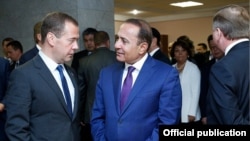Armenia has proposed that the prices of natural gas and other “strategic” commodities traded within the Russian-led Eurasian Economic Union (EEU) be set in Russian rubles, rather than U.S. dollars, the Armenian government confirmed on Wednesday.
According to the Belarusian news agency BELTA, Prime Minister Hovik Abrahamian floated the idea on Tuesday at a meeting of the prime ministers of the EEU member states held in Grodno, Belarus. Abrahamian was reported to stress the need to reduce the high degree of “dollarization” in trade among Russia, Kazakhstan, Belarus, Armenia and Kyrgyzstan. For that purpose, he said, they should “carry out mutual trade in strategic goods on the basis of the ruble.”
Abrahamian’s spokeswoman, Gohar Poghosian, confirmed the information. “He primarily referred to energy resources,” Poghosian told RFE/RL’s Armenian service (Azatutyun.am). “But ruble-denominated trade could also apply to other strategic commodities.”
It is not clear whether the Armenian proposal was backed by any of the other EEU member states. Only two of them, Russia and Kazakhstan, are rich in oil and gas. Russia is also one of the world’s leading exporters of wheat.
President Serzh Sarkisian apparently voiced the same proposal when he met with his Russian counterpart Vladimir Putin outside Moscow on Monday. “The price of energy resources for Armenia remains the key issue,” he told Putin. “In this crisis situation, exchange rate fluctuations have a very painful impact on [Armenian energy] tariffs, and I very much hope that we will find new solutions, good solutions.”
A nearly 17 percent depreciation of the Armenian dram recorded late last year was the main official rationale for state regulators’ decision in June to raise electricity prices in Armenia for a third time in two years. The regulators argued that the weaker dram has pushed up the cost of Russian natural gas generating around 40 percent of Armenia’s electricity.
That explanation did not satisfy most Armenians. Thousands of them demonstrated in Yerevan against the price hike in late June and early July. The protests forced the Sarkisian government to subsidize the energy tariffs for households and some small businesses.
The Russian currency has weakened much more drastically over the past year.




